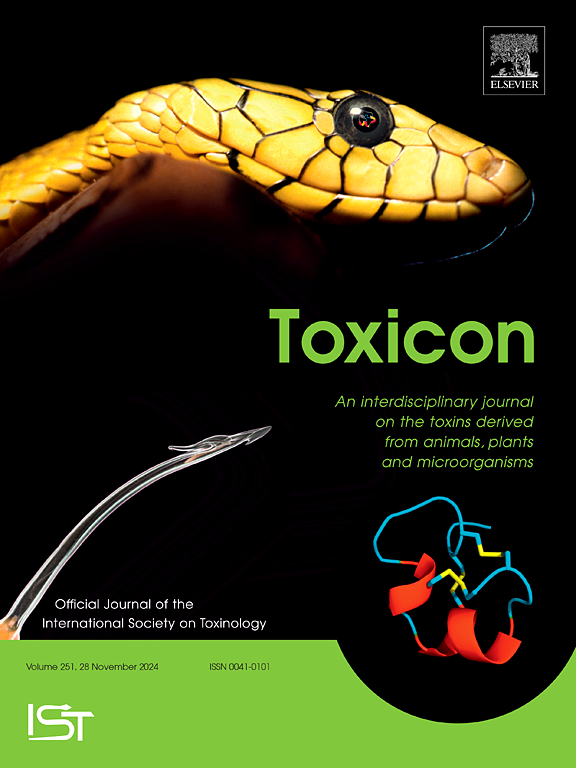繁殖形成的浮游微囊藻和底栖镜藻诱发幼年鲢鱼和鳙鱼的氧化应激和炎症反应。
IF 2.6
4区 医学
Q2 PHARMACOLOGY & PHARMACY
引用次数: 0
摘要
随着全球变暖和水体富营养化,有害蓝藻的大量繁殖会形成藻华,造成严重的生态问题。近年来,大规模、持续性的蓝藻水华在全球范围内频繁发生,其危害性已引起广泛关注。在这些形成蓝藻水华的有害藻类中,浮游蓝藻对生态学和毒理学的影响已被广泛研究。然而,对有害底栖蓝藻的生态风险和不利影响的研究则相对滞后。滤食性鱼类由于其特殊的摄食习性,可能比其他鱼类受到更多的毒性刺激。为了研究和比较不同种类的有害蓝藻对鱼类的复杂毒性效应,研究人员将三种不同体型(即小、中、大)的幼年鲢鱼(Hypophthalmichthys molitrix)和鳙鱼(Aristichthys nobilis)暴露于蓝藻藻华相关密度(1 × 106 cells/mL)的铜绿微囊藻(即产生微囊藻毒素)中。(即产生微囊藻毒素)和振荡器藻(即产生圆柱形藻毒素)的蓝藻藻华相关密度(1×106 个细胞/毫升),然后检测鱼类肝脏中氧化应激和炎症的生物标志物。通过测量蓝藻毒素的含量,鲢鱼和鳙鱼可以有效地摄取微囊藻细胞,但不能有效地摄取鞘氨醇细胞。微囊藻细胞和鞘氨醇细胞都能通过改变抗氧化系统(如超氧化物歧化酶活性)和免疫系统(如白细胞介素-1β水平)的生化参数,在这些滤食性幼鱼的肝脏中诱导不同程度的氧化应激和炎症反应。因此,我们的研究发现了潜在的数据缺口,即不同类型的蓝藻如何在短时间内诱导滤食性幼鱼肝脏的毒性效应。本研究有助于更好地理解不同种类蓝藻对幼鱼的短期不利影响,表明底栖有毒蓝藻诱导的生态和健康风险需要进一步关注。本文章由计算机程序翻译,如有差异,请以英文原文为准。

Bloom-forming planktonic Microcystis and benthic Oscillatoria-induced oxidative stress and inflammatory responses in juvenile silver carp and bighead carp
As global warming and water eutrophication, the multiple proliferation of harmful cyanobacteria can form algal blooms and cause serious ecological problems. In recent years, the large-scale and persistent cyanobacterial blooms occur frequently worldwide and have attracted widespread attention due to the harmful impacts. Among these harmful bloom-forming cyanobacteria, the ecological and toxicological impacts of planktonic cyanobacteria have been extensively studied. However, research on the ecological risks and adverse effects of harmful benthic cyanobacteria is lagging. Filter-feeding fish could suffer from more toxic stimuli than other fish due to their special feeding habits. To investigate and compare the complex toxic effects of different kinds of harmful cyanobacteria on fish, three different-sized (i.e. small, medium, and large) juvenile silver carp (Hypophthalmichthys molitrix) and bighead carp (Aristichthys nobilis) were exposed to cyanobacterial blooms-related density (1 × 106 cells/mL) of Microcystis aeruginosa (i.e. generating microcystins) and Oscillatoria sp. (i.e. generating cylindrospermopsin) for 3 d, after which biomarkers of oxidative stress and inflammation in the liver of fish were detected. The silver carp and bighead carp can effectively ingest Microcystis cells but cannot effectively ingest Oscillatoria cells through the measurement of the levels of cyanotoxins. Both Microcystis and Oscillatoria cells can induce different levels of oxidative stress and inflammatory responses in the liver of these juvenile filter-feeding fish via altering the biochemical parameters of the antioxidant system (e.g. superoxide dismutase activity) and immune system (e.g. interleukin-1β level). Therefore, our research identified potential data gaps that how the different types of cyanobacteria induce toxic effects in the liver of juvenile filter-feeding fish in a short time. This study contributes to a better understanding of the short-term adverse effects of different cyanobacterial species on juvenile fish, suggesting that the benthic toxic cyanobacteria-induced ecological and health risks require further attention.
求助全文
通过发布文献求助,成功后即可免费获取论文全文。
去求助
来源期刊

Toxicon
医学-毒理学
CiteScore
4.80
自引率
10.70%
发文量
358
审稿时长
68 days
期刊介绍:
Toxicon has an open access mirror Toxicon: X, sharing the same aims and scope, editorial team, submission system and rigorous peer review. An introductory offer Toxicon: X - full waiver of the Open Access fee.
Toxicon''s "aims and scope" are to publish:
-articles containing the results of original research on problems related to toxins derived from animals, plants and microorganisms
-papers on novel findings related to the chemical, pharmacological, toxicological, and immunological properties of natural toxins
-molecular biological studies of toxins and other genes from poisonous and venomous organisms that advance understanding of the role or function of toxins
-clinical observations on poisoning and envenoming where a new therapeutic principle has been proposed or a decidedly superior clinical result has been obtained.
-material on the use of toxins as tools in studying biological processes and material on subjects related to venom and antivenom problems.
-articles on the translational application of toxins, for example as drugs and insecticides
-epidemiological studies on envenoming or poisoning, so long as they highlight a previously unrecognised medical problem or provide insight into the prevention or medical treatment of envenoming or poisoning. Retrospective surveys of hospital records, especially those lacking species identification, will not be considered for publication. Properly designed prospective community-based surveys are strongly encouraged.
-articles describing well-known activities of venoms, such as antibacterial, anticancer, and analgesic activities of arachnid venoms, without any attempt to define the mechanism of action or purify the active component, will not be considered for publication in Toxicon.
-review articles on problems related to toxinology.
To encourage the exchange of ideas, sections of the journal may be devoted to Short Communications, Letters to the Editor and activities of the affiliated societies.
 求助内容:
求助内容: 应助结果提醒方式:
应助结果提醒方式:


